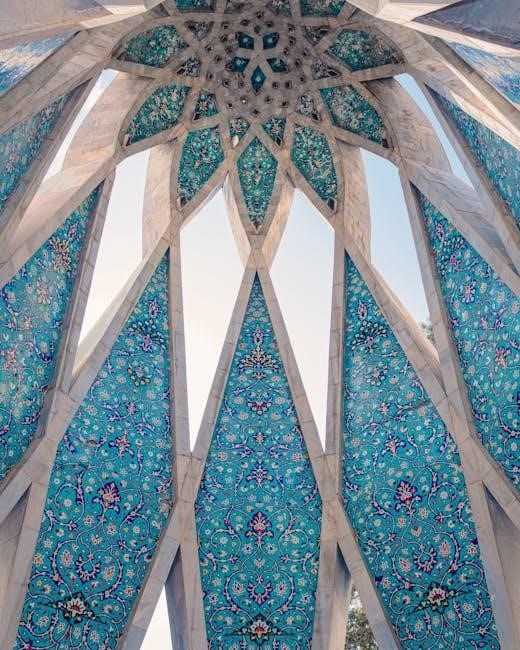Omar Khayyam, a Persian poet, mathematician, and astronomer, is renowned for his Rubaiyat, a collection of quatrains exploring existentialism, hedonism, and mysticism. The PDF version offers convenient access to this timeless masterpiece.
1.1. Who Was Omar Khayyam?
Omar Khayyam was a Persian polymath, excelling as a poet, mathematician, astronomer, and philosopher during the 11th century. Born in Nishapur, Persia (modern-day Iran), around 1048, he gained recognition for his intellectual contributions, particularly in algebra and astronomy. His poetic works, especially the Rubaiyat, are celebrated for their deep philosophical insights and lyrical beauty. Khayyam’s verses often explored themes of existentialism, hedonism, and the fleeting nature of life, resonating with readers across centuries. Despite his scholarly achievements, Khayyam’s verses were not widely known in the West until Edward FitzGerald’s 19th-century translation. His legacy endures as a symbol of wisdom, blending scientific rigor with poetic elegance, making him one of the most revered figures in Persian literature.
1.2. The Significance of the Rubaiyat
The Rubaiyat, a collection of poetic quatrains attributed to Omar Khayyam, holds profound cultural and literary significance. Its exploration of themes such as existentialism, hedonism, and mysticism resonates universally, offering insights into life’s fleeting nature and humanity’s quest for meaning. The verses, often lyrical and introspective, blend philosophical depth with poetic beauty, making them timeless. Translated into numerous languages, the Rubaiyat has transcended cultural boundaries, inspiring readers globally. Its significance lies in its ability to provoke thought while remaining accessible, a rare balance that has cemented its place in world literature. The PDF versions of the Rubaiyat, particularly Edward FitzGerald’s translation, have further amplified its reach, ensuring its ideas continue to captivate modern audiences seeking wisdom and reflection.
1.3. Overview of the PDF Version
The PDF version of the Rubaiyat of Omar Khayyam offers a convenient and accessible way to explore this timeless literary masterpiece. Available for free download from various online sources, such as Internet Archive and Project Gutenberg, the PDF format ensures that readers worldwide can easily access and engage with the text. Many editions include Edward FitzGerald’s iconic translation, which first popularized the Rubaiyat in the 19th century. The digital version often features both the original Persian text and its English translation, providing a rich cultural and linguistic experience. With its portability and ease of use, the PDF version has made the Rubaiyat more accessible than ever, allowing modern readers to delve into its profound themes and poetic beauty at their convenience.
The Structure and Themes of the Rubaiyat
Omar Khayyam’s Rubaiyat is structured as a collection of quatrains, each exploring themes of existentialism, hedonism, and mysticism, blending philosophical depth with poetic elegance.
2.1. The Poetic Form of the Rubaiyat
The Rubaiyat is composed of quatrains, four-line verses with a consistent rhyme scheme, typically following the AABA pattern. Each quatrain serves as a standalone reflection, yet collectively, they weave a cohesive tapestry of thought. The poetic form is characterized by its lyrical elegance, blending philosophical musings with vivid imagery. Wine, love, and nature are recurring metaphors, while the verses often conclude with a moral or existential insight. FitzGerald’s translation masterfully adapts the Persian originals into English verse, preserving the essence of Khayyam’s contemplative style. The structure allows for both personal interpretation and universal resonance, making the Rubaiyat a timeless literary gem. Its concise yet profound form has captivated readers, ensuring its enduring appeal across centuries and cultures.
2.2. Major Themes: Existentialism, Hedonism, and Mysticism
The Rubaiyat delves into profound themes, blending existential contemplation, hedonistic joy, and mystical introspection. Khayyam’s verses often question the meaning of life, fate, and the universe, reflecting existentialist ideas. He muses on the fleeting nature of existence, urging readers to cherish the present. Hedonism is another central theme, as Khayyam celebrates wine, love, and sensory pleasures, advocating for living fully in the moment. Mysticism intertwines with these ideas, exploring the divine and the unknown, often through Sufi-inspired imagery. Together, these themes create a rich philosophical tapestry, inviting readers to ponder life’s mysteries while embracing its beauty. The interplay of these ideas has made the Rubaiyat a timeless exploration of human experience, resonating across cultures and centuries.
2.3. Key Verses and Their Interpretations
The Rubaiyat contains numerous iconic verses that have sparked profound interpretations. One of the most celebrated lines, “Awake! For Morning in the Bowl of Night / Has flung the Stone that puts the Stars to Flight,” symbolizes the awakening of consciousness and the fleeting nature of time. Another verse, “The Moving Finger writes, and having writ, / Moves on: nor all your Piety nor Wit / Shall lure it back to cancel half a Line,” reflects on the inevitability of fate and the futility of regret. These verses, among others, explore themes of existentialism, hedonism, and mysticism, inviting readers to contemplate life’s mysteries and embrace its transient beauty. Their interpretations vary, but they collectively embody Khayyam’s philosophical depth and poetic brilliance, making the Rubaiyat a timeless exploration of human existence.

Edward FitzGerald’s Translation
Edward FitzGerald’s 1859 translation of the Rubaiyat introduced Omar Khayyam’s poetry to the Western world, blending poetic beauty with philosophical depth. His work remains a cornerstone of English literature, with the PDF version preserving its timeless appeal for modern readers.
3.1. The Role of Edward FitzGerald in Popularizing the Rubaiyat
Edward FitzGerald played a pivotal role in introducing Omar Khayyam’s Rubaiyat to the Western world through his 1859 translation. His poetic rendering of the quatrains captured the essence of Khayyam’s philosophical musings, blending hedonism and mysticism. FitzGerald’s work transformed the Rubaiyat into a literary sensation, making it accessible to English-speaking audiences. Despite initial modest success, the translation gained widespread acclaim, becoming a cornerstone of 19th-century English literature. FitzGerald’s interpretation not only highlighted Khayyam’s poetic genius but also sparked global interest in Persian poetry. The PDF version of FitzGerald’s translation remains a popular choice for readers, ensuring his adaptation continues to inspire and influence modern audiences. His role in popularizing the Rubaiyat is undeniable, cementing its place as a timeless classic in world literature.
3.2. The First Version of the Translation
Edward FitzGerald’s first version of the Rubaiyat, published in 1859, marked the initial English translation of Omar Khayyam’s quatrains. This pioneering work introduced the West to Khayyam’s philosophical and poetic genius. FitzGerald’s translation was not a literal rendering but a poetic adaptation, capturing the essence of Khayyam’s themes. The first version was published anonymously and initially received little attention, selling few copies. However, its unique blend of lyrical beauty and existential musings gradually attracted notice. The translation’s adaptive style allowed it to resonate with Victorian readers, despite its departure from the original Persian structure. This first version laid the groundwork for the Rubaiyat’s enduring popularity, making it a foundational text in English literature. Its success paved the way for subsequent editions, cementing FitzGerald’s role as a bridge between Persian and English literary traditions.
3.3. The Impact of FitzGerald’s Translation on English Literature
Edward FitzGerald’s translation of the Rubaiyat had a profound impact on English literature, introducing Victorian readers to Persian poetry’s philosophical depth and lyrical beauty. The work became a cultural phenomenon, sparking widespread interest in Oriental literature and influencing writers like Tennyson and Wilde. FitzGerald’s poetic adaptation, rather than a literal translation, allowed the Rubaiyat to resonate with Western audiences, blending Eastern mysticism with universal themes of existentialism and hedonism. Its success inspired a wave of translations and adaptations, enriching English poetry with new forms and ideas. The Rubaiyat also played a key role in the Aesthetic Movement, emphasizing beauty and sensual experience. FitzGerald’s version remains a landmark, shaping perceptions of Omar Khayyam and enduring as a masterpiece of English literature, bridging cultural and linguistic divides for generations of readers.

The Historical Context of the Rubaiyat
Omar Khayyam’s Rubaiyat reflects the intellectual and cultural vibrant 11th-century Persia, blending his scientific brilliance with poetic reflections on life, fate, and existence. The PDF version preserves this historical masterpiece.
4.1. The Life and Times of Omar Khayyam
Omar Khayyam, a 11th-century Persian polymath, excelled as a mathematician, astronomer, and poet. Born in Nishapur, he made significant contributions to algebra and calendar reform. His poetic works, particularly the Rubaiyat, blend philosophical musings on life, fate, and existential themes. Khayyam’s life reflects the cultural and intellectual vibrancy of Persia during the Seljuk Empire. Despite his scientific achievements, his poetry gained widespread recognition posthumously, especially after Edward FitzGerald’s translation. The Rubaiyat’s exploration of hedonism, mysticism, and the fleeting nature of life resonates universally. The PDF version of the Rubaiyat provides a modern avenue to explore Khayyam’s timeless wisdom, bridging centuries and cultures effortlessly.
4;2. The Rubaiyat’s Reception in the 11th Century
The Rubaiyat of Omar Khayyam initially received modest attention in the 11th century, as Khayyam was more renowned for his scientific contributions than his poetry. The quatrains were likely circulated among intellectual and literary circles, with themes of existentialism and hedonism sparking debate. Khayyam’s philosophical musings on life’s fleeting nature resonated with some, while others, particularly religious scholars, found his views controversial. The Rubaiyat’s blend of mysticism and skepticism challenged traditional norms, limiting its widespread acceptance. Despite this, the work’s poetic beauty and depth earned it a dedicated following. The PDF version of the Rubaiyat now allows modern readers to explore these timeless verses, offering insights into the intellectual climate of 11th-century Persia and Khayyam’s enduring legacy.
4.3. The Rediscovery of the Rubaiyat in the West
The Rubaiyat of Omar Khayyam remained relatively obscure in the West until the 19th century, when it was rediscovered and popularized through Edward FitzGerald’s groundbreaking translation. FitzGerald’s rendition, first published in 1859, introduced the quatrains to English-speaking audiences, sparking widespread interest in Khayyam’s philosophy and poetry. The translation’s lyrical beauty and existential themes resonated with the Victorian era’s intellectual and artistic circles, leading to the Rubaiyat’s rise as a cultural phenomenon. This rediscovery not only revitalized interest in Persian literature but also influenced Western literary and artistic movements. The PDF version of FitzGerald’s translation has further cemented the Rubaiyat’s accessibility, ensuring its timeless wisdom continues to captivate readers globally.

The Rubaiyat’s Influence on Art and Literature
The Rubaiyat’s profound themes inspired 19th-century writers and artists, shaping literary movements and sparking creative interpretations. Its philosophical depth continues to influence modern art and literature globally.
5.1. The Rubaiyat’s Impact on 19th-Century Literature
Edward FitzGerald’s translation of the Rubaiyat in 1859 became a cultural phenomenon, profoundly influencing 19th-century literature. Its blend of Eastern mysticism and existential themes resonated with Victorian intellectuals, sparking debates on spirituality and hedonism. Writers like Alfred Tennyson and Robert Browning drew inspiration from its philosophical depth, while the Pre-Raphaelite Brotherhood embraced its aesthetic and emotional richness. The Rubaiyat’s exploration of life’s transience and the pursuit of pleasure aligned with the era’s growing interest in individualism and introspection. Its verses also influenced the Aesthetic Movement, emphasizing beauty and sensory experience. The PDF version of the Rubaiyat further widened its reach, making it accessible to a broader audience and cementing its place as a cornerstone of 19th-century literary and cultural transformation.
5.2. Illustrations and Art Inspired by the Rubaiyat

The Rubaiyat has inspired countless artistic interpretations, with its themes of existential contemplation and hedonism captivating visual artists. Illustrators like Edmund J. Sullivan and Willy Pogany created iconic artwork for various editions, blending Persian motifs with Western aesthetics. These illustrations, often included in PDF versions, enhance the poetic experience, visually interpreting the quatrains’ philosophical depth. The art ranges from intricate calligraphy to lush, symbolic landscapes, reflecting the poem’s universal appeal. Digital formats have further democratized access to these visuals, ensuring the Rubaiyat’s artistic legacy endures. The interplay of text and image continues to enrich readers’ connections to Omar Khayyam’s timeless wisdom.
5.3. The Rubaiyat’s Role in Popular Culture
The Rubaiyat’s profound themes and poetic beauty have left an indelible mark on popular culture. Its verses have been referenced in music, film, and literature, with artists like The Beatles drawing inspiration from its existential and hedonistic themes. The poem’s philosophical musings have also been adapted into various forms of media, from stage productions to digital art. In the digital age, the PDF version of the Rubaiyat has further amplified its reach, allowing modern audiences to engage with its timeless wisdom. Its influence is evident in quotes appearing in TV shows, movies, and even advertisements, showcasing its enduring appeal. The Rubaiyat’s ability to transcend cultural and temporal boundaries continues to captivate global audiences, ensuring its relevance in contemporary popular culture.

The PDF Version of the Rubaiyat
The Rubaiyat of Omar Khayyam is widely available in PDF format, offering readers easy access to its timeless verses. This digital version preserves the poetic essence while enhancing readability and portability, allowing audiences to engage with the text anywhere. The PDF is accessible for free on platforms like Internet Archive and Librivox, ensuring its philosophical and lyrical beauty reaches a global audience. Illustrations and translations, such as Edward FitzGerald’s rendition, are often included, enriching the experience. While e-books provide convenience, they also remind us of the value of physical books, encouraging support for publishers. This format ensures the Rubaiyat’s enduring appeal remains vibrant in the digital age.
6.1. Benefits of the Digital Version
The digital version of the Rubaiyat offers unparalleled accessibility and convenience. Readers can download the PDF instantly, accessing the text anytime and anywhere. This format is ideal for modern readers, enabling them to carry the timeless wisdom of Omar Khayyam on their devices. The digital version also supports keyword searches, making it easier to explore specific themes or verses. Additionally, free availability on platforms like Internet Archive ensures that this literary masterpiece reaches a global audience, fostering its enduring appeal. The PDF preserves the poetic beauty while offering adjustable font sizes and layouts, enhancing readability. Overall, the digital Rubaiyat bridges tradition and modernity, making it a versatile and enduring resource for literature enthusiasts.

6.2. Where to Find the Rubaiyat PDF for Free
The Rubaiyat of Omar Khayyam in PDF format is widely available for free download from various reputable sources. Platforms such as Internet Archive, Google Books, and Project Gutenberg offer high-quality versions of the text, often accompanied by historical introductions and annotations. These websites provide easy access to Edward FitzGerald’s classic translation, ensuring that readers can explore Khayyam’s timeless wisdom without cost. Additionally, many academic and literary websites host free PDF versions, making it simple to find and download the Rubaiyat. These resources are particularly valuable for students, researchers, and enthusiasts seeking to delve into the poem’s philosophical and poetic depths. The availability of these free PDFs ensures that Khayyam’s work remains accessible to a global audience, preserving its cultural and literary significance for future generations.
6.3. Popular Editions of the Rubaiyat in PDF
The Rubaiyat of Omar Khayyam is available in various popular PDF editions, each offering unique features. Edward FitzGerald’s original 1859 translation remains the most widely recognized and downloaded version. Illustrated editions, such as those featuring artwork by Edmund J. Sullivan, are also highly sought after for their visual and aesthetic appeal. Modern translations and annotated versions provide deeper insights into Khayyam’s philosophy and poetic style. Additionally, bilingual editions, presenting the original Persian text alongside English translations, are popular among scholars and language enthusiasts. These editions are readily available on platforms like Internet Archive, Project Gutenberg, and academic repositories, ensuring accessibility for readers worldwide. The diversity of these PDF editions caters to different preferences, making the Rubaiyat a timeless and versatile literary treasure.

The Legacy of the Rubaiyat

The Rubaiyat’s enduring appeal lies in its timeless exploration of existentialism, hedonism, and mysticism, resonating across cultures and centuries. Its influence on literature and culture remains profound, with PDF versions ensuring its accessibility to modern readers.
7.1. The Enduring Appeal of the Rubaiyat
The Rubaiyat of Omar Khayyam continues to captivate readers with its timeless themes of existentialism, hedonism, and mysticism. Its poetic exploration of life’s fleeting nature, the pursuit of happiness, and the search for meaning resonates universally. The verses, rendered into English by Edward FitzGerald, have become a cornerstone of world literature, blending philosophical depth with lyrical beauty. The PDF version ensures that this masterpiece remains accessible, allowing modern audiences to engage with its profound insights. Its enduring appeal lies in its ability to evoke reflection and inspire contemplation, making it a cherished work across generations and cultures. The Rubaiyat’s legacy is a testament to the power of poetry to transcend time and borders, offering wisdom and solace to readers seeking understanding of life’s complexities.
7.2. The Rubaiyat’s Relevance in Modern Times
The Rubaiyat of Omar Khayyam remains strikingly relevant in modern times, offering insights into universal human experiences. Its themes of existential contemplation, the fleeting nature of life, and the pursuit of happiness resonate deeply with contemporary audiences. The PDF version of the Rubaiyat has made it easily accessible, allowing readers to engage with its timeless wisdom in a digital age. Its exploration of existentialism, hedonism, and mysticism continues to inspire reflection on life’s purpose and meaning. The Rubaiyat’s enduring relevance lies in its ability to transcend cultural and temporal boundaries, addressing questions that are as pertinent today as they were in the 11th century. Its poetic and philosophical depth ensures its continued influence on modern thought and literature, making it a timeless treasure for readers worldwide.
7.3. The Future of the Rubaiyat in Digital Formats
The Rubaiyat of Omar Khayyam is poised to thrive in digital formats, ensuring its timeless wisdom reaches future generations. The rise of e-books and PDF versions has already made the text more accessible, allowing readers worldwide to engage with its poetic and philosophical depth. Digital platforms like Internet Archive and Librivox offer free access to the Rubaiyat, fostering a broader audience. Enhanced features such as hyperlinks, annotations, and multimedia integration can further enrich the reading experience. As technology evolves, the Rubaiyat’s digital presence will likely expand, incorporating interactive elements and new translations. This adaptability ensures that Omar Khayyam’s work remains relevant and accessible, bridging the gap between traditional literature and modern digital culture. The PDF format, in particular, will continue to play a vital role in preserving and sharing this enduring masterpiece.
The Rubaiyat of Omar Khayyam remains a timeless literary treasure, offering profound reflections on life and existence. Its availability in PDF ensures accessibility for modern readers, preserving its enduring appeal.
8.1. Final Thoughts on the Rubaiyat’s Significance
The Rubaiyat of Omar Khayyam stands as a profound exploration of existential themes, blending hedonism, mysticism, and philosophical inquiry. Its timeless verses resonate universally, offering insights into life’s fleeting nature and humanity’s quest for meaning. The PDF version ensures accessibility, preserving Khayyam’s wisdom for modern readers. His work transcends cultures, inspiring countless adaptations and interpretations. The Rubaiyat’s enduring appeal lies in its ability to provoke reflection on existence, love, and the cosmos. As a literary masterpiece, it continues to captivate hearts and minds, solidifying its place in world literature. Omar Khayyam’s legacy endures, reminding us of the beauty and complexity of human experience. The Rubaiyat remains a testament to the power of poetry to transcend time and borders, offering timeless wisdom to generations.
8.2. Encouragement to Explore the PDF Version
Exploring the PDF version of the Rubaiyat of Omar Khayyam offers a convenient and accessible way to engage with this timeless masterpiece. The digital format ensures that Khayyam’s profound verses are readily available for readers worldwide. The PDF version often includes Edward FitzGerald’s iconic translation, which beautifully captures the essence of the original Persian quatrains. Many editions also feature stunning illustrations, enhancing the reader’s experience. Whether you’re a scholar, literature enthusiast, or simply curious, the PDF provides an opportunity to delve into the Rubaiyat’s existential reflections, hedonistic musings, and mystical insights. With just a click, you can immerse yourself in the poetic genius of Omar Khayyam and appreciate the enduring relevance of his work in modern times.
8.3. The Timeless Wisdom of Omar Khayyam

Omar Khayyam’s Rubaiyat embodies timeless wisdom, blending philosophical reflection with poetic beauty. His verses, rooted in existentialism, hedonism, and mysticism, continue to resonate across centuries, offering insights into life’s fleeting nature and humanity’s eternal quest for meaning. Khayyam’s work transcends cultural and temporal boundaries, appealing to readers seeking both intellectual stimulation and emotional solace. The PDF version of the Rubaiyat ensures his teachings remain accessible, allowing modern audiences to engage with his profound musings on love, fate, and the universe. His words encourage living fully, embracing the present, and finding balance between reason and passion. Through the Rubaiyat, Omar Khayyam’s legacy endures, inspiring reflection and contemplation in an ever-changing world.
